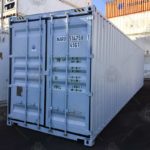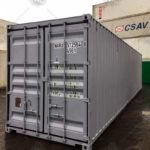Container Sizes
Container sizes – measurements for shipping containers
It doesn’t really matter whether you are looking for a container to build a house, a temporary storage unit, or if you use it for transportation: measurements are everything. In this article, you find all the information you need about the sizes of containers and the measurements of TEU (Twenty-foot Equivalent Unit) and FEU (Forty-foot Equivalent Unit). We also explain why standardized measures are so important for international cargo shipping.
Measurements of shipping containers – overview
| Container Type | Internal dimensions mm (LxWxH) | External dimensions mm (LxWxH) | Door opening mm (LxH) | Floor space m² | Volume m³ |
| 8-Fuß-Container | 2.278 x 2.112 x 2.060 | 2,438 x 2,200 x 2.260 | 2.100 x 1.949 | 4,81 | 9,92 |
| 10-Fuß-Container | 2.831 x 2.352 x 2.390 | 2.991 x 2.438 x 2.591 | 2.338 x 2.280 | 6,66 | 15,9 |
| 20-Fuß-Container (1-TEU-Container) | 5.898 x 2.352 x 2.390 | 6.058 x 2.438 x 2.591 | 2.338 x 2.280 | 13,88 | 33,1 |
| 20-Fuß („High Cube“) | 5.898 x 2.352 x 2.690 | 6.058 x 2.438 x 2.896 | 2.338 x 2.585 | 13,88 | 37,4 |
| 40-Fuß-Container (1-FEU-Container) | 12.032 x 2.352 x 2.395 | 12.192 x 2.438 x 2.591 | 2.340 x 2.280 | 28,37 | 67,7 |
| 40-Fuß („High Cube“) | 12.032 x 2.352 x 2.698 | 12.192 x 2.438 x 2.896 | 2.340 x 2.585 | 28,37 | 76,4 |
| 45-Fuß („High Cube“) | 13.556 x 2.345 x 2.695 | 13.716 x 2.438 x 2.896 | 2.340 x 2.597 | 31,79 | 86,0 |
What does the ISO norm mean?
The ISO norm 668 was defined in 1968. This international standard regulates the dimensions and weight specifications of intermodal freight containers. All relevant parameters concerning freight containers are defined by this norm, among them:
In the following years, ISO 668 was amended and extended several times. The current version is ISO R-668 E/2013. This universal standard has major advantages for transport. Because all containers are identical in construction, they can be handled in all terminals worldwide. They can easily be stacked on all vessels, no matter if it is a ship of Asian, European, or American country of origin. They also fit on any truck for container transportation as well as on any freight train.
Container sizes: What are “TEU” and “FEU”?
The abbreviation “TEU,” as mentioned above, stands for “Twenty Foot Equivalent Unit.” It refers to a 20-ft container, which, in Germany, is a standard shipping container. This size is internationally normed and is used to calculate the capacity of container vessels and for handling values in ports. For example: If a ship has a capacity of 1,500 TEU, there is room for 1,500 standard 20-ft containers. One foot is the equivalent of 0.30479 m.
FEU, accordingly, is short for “Forty Foot Equivalent Unit” and denotes the capacity of one 40-ft container, which, in turn, equals two TEU.
Interior measurements
The interior measurement of one TEU container is 5,898 mm x 2,352 mm x 2,390 mm, for one FEU, it’s 12,032 mm x 2,352 mm x 2,395 mm. Different finishes or extensions, however, may change these dimensions. Platform containers, for example, only consist of a foundation without walls; reefer containers, that are designed to transport food and beverages, are equipped with a separate cooling unit and insulation. Hazmat containers made for transporting hazardous materials like fuel, oil, or gas are equipped with integrated baffles and an explosion-safe electric installation. Specially designed air freight containers differ in form and size, since they are optimized for fitting into aircrafts.
How much fits into a container?
A shipping container is a space miracle. It may look small, but you can fit a lot into it – a lot more than you may think. Depending on the measurements, storing direction, stacking capability and height of the freight, a standard TEU has room for:
When transporting goods on pallets, the carrying capacity needs to be taken into account. Also, the goods may not exceed the dimensions of each pallet.
You have further questions? You want to buy a used shipping container or reefer? Contact us today – we will find the right solution for your business!
WHY CHOOSE US?
Worldwide Service
We sell and transport containers worldwide.
Expert Business And Handling
Not only do we offer reefer containers for sale, we also offer repairs and specialised builds.
Always In Stock
At our container depot in Hamburg, we always have over 400 containers for sale.



